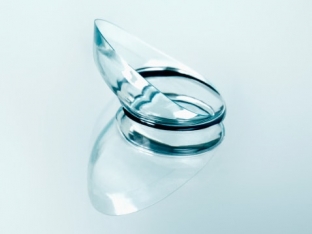Contact lenses are very popular all over the world: they not only allow people with visual impairments to do without the inconvenience associated with wearing glasses, but also provide an opportunity to experiment with eye color. Despite all the advantages of contact lenses, it must be remembered that they are primarily a medical product, and if used incorrectly, they can cause eye infections. Estet-portal.com will tell you which eye infections can be caused by wearing lenses incorrectly and how they can be avoided.
Eye infections: infectious keratitis
Contact lenses increase the risk of developing keratitis – inflammation of the cornea of the eye, the origin of which may be traumatic or infectious. In the event of such inflammation of the eye, which can also be caused by contact lenses, the following symptoms appear:
- impaired vision;
- clotting of the cornea;
- eye redness;
- pain in the eyes (even after removing the lenses);
- increased tearing or discharge from the eyes;
- gas discomfort;
- photophobia.
If these symptoms appear, you should consult an ophthalmologist!
Eye infections that can occur when wearing contact lenses
There are four main types of eye infections that require immediate medical attention if symptoms are detected.
1. Bacterial eye infections.
Bacteria, including Staphylococcus aureus and Pseudomonas aeruginosa, can enter the eyes through contact lenses. These bacteria can enter the eye if the contact lens is not clean enough. With such an eye infection, the doctor prescribes antibiotics.
The risk of bacterial infections is increased if:
- do not remove lenses at night;
- use hard contact lenses to correct myopia;
- it is not enough to thoroughly rinse lenses or their storage containers;
- wear someone else's lenses.
2. Parasitic eye infections.
Acanthameba keratitis caused by acanthamoeba – the simplest microorganism can lead not only to loss of vision, but also to blindness. These eye infections are most common among contact lens wearers.
 This infection is quite rare, it can be brought in if you do not follow the rules of hygiene – wash the lenses with running water, do not store in a special solution or in a solution diluted with tap water, do not remove the lenses while swimming or bathing, etc.
This infection is quite rare, it can be brought in if you do not follow the rules of hygiene – wash the lenses with running water, do not store in a special solution or in a solution diluted with tap water, do not remove the lenses while swimming or bathing, etc.
Symptoms of Acanthamoeba keratitis are similar to those of other eye infections:
- eye redness;
- pain in the eyes;
- blurred vision;
- photophobia;
- feeling of a foreign body in the eye.
In the case of such an infection, it is important to see a doctor as soon as possible, as it is difficult to treat even in the early stages, let alone advanced cases.
3. Viral eye infections.
Herpes simplex virus type 1 may well cause infection of the eye. This infection is called ophthalmoherpes or eye herpes. To reduce the risk of introducing the herpes virus into the eye, you must be careful about hygiene and avoid touching your eyes with your hands, which you could accidentally or intentionally touch the herpes vesicles.
Herpetic eye infection most often leads to the above-described keratitis, respectively, is accompanied by the same symptoms, and the doctor is involved in the diagnosis and treatment – You are unlikely to be able to determine the causative agent of the infection at home.
4. Fungal eye infections.
Keratitis can also be fungal, and the risk of it increases with the use of contact lenses. Often such keratitis can be caused by injury to the eyes of plants (for example, if a chip, stick, or other body of plant origin gets into the eye). People with weakened immune systems are most at risk of developing this eye infection.
Remember that the main cause of eye infections caused by contact lenses is poor hygiene. To minimize the risk of eye infection, you must:
- remove lenses if pain, redness or irritation occurs;
- before handling lenses, be sure to wash your hands thoroughly with soap and water;
- wash lenses and containers for their storage only with a special solution;
- do not wash lenses with tap water;
- do not dilute the cleaning solution with tap water;
- do not store lenses in tap water;
- remove lenses before swimming, swimming or showering;
- remove lenses at night;
- do not share contact lenses with another person;
- visit an ophthalmologist regularly.






Add a comment